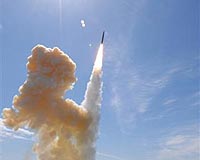| . |  |
. |
Tokyo (UPI) Jul 2, 2009 A new $935 million project called the Japan Aerospace Defense Ground Environment has been initiated to improve the country's automatic air warning and defense control system. JADGE has replaced the Base Air Defense Ground Environment, said Japan's air arm, the Air Self-Defense Force. Japan's official military policy of Self-Defense Only does not allow the nation's armed forces to have strategic bombers, so JADGE is to improve the ASDF's capabilities to counter airborne attacks, such as by airplanes. The new air-defense network also integrates Japan's ballistic missile sensors and interception systems, and is central to protecting the country from ballistic missile attacks by improving early warning systems. JADGE begins operating amid increasing concerns about the threat of North Korean missiles. The Japanese government approved plans at the beginning of June to develop a satellite early warning system for missile launches. Tensions were heightened in April when North Korea launched what it said was a satellite-bearing rocket. It then conducted a nuclear test and several short-range missile launches. JADGE goes some way to satisfying the government's critics that the country's satellite detection systems need upgrading. The superseded Base Air Defense Ground Environment was an integrated network of radar posts and air defense installations throughout the country. BADGE was upgraded in the 1980s with E-2C Hawkeye airborne early warning aircraft. Other aircraft were replaced in the early 1990s with more sophisticated models. These included the Nike-J, a Japanese version of the Nike-Hercules surface-to-air missile from Mitsubishi Heavy Industries, and the Patriot PAC-2 ground-to-air missile system built by Raytheon. The ASDF started deploying PAC-3 systems in 2007 and last September successfully tested its capability in New Mexico's White Sands Missile Range. It shot down a mock ballistic missile by firing two PAC-3 missiles in succession. The tests were to gather operational data on the system's radar, launcher and controller set-ups. The government decided in 2003 to build a ballistic missile shield, so antiballistic missile functions were added to the concept. JADGE is now central to the country's ballistic missile shield through search, detection, tracking and interception of ballistic missiles in a centralized and automated manner, according to the ASDF. The new network, which was originally centralized at a base in Fuchu in the suburbs of Tokyo, is also linked to U.S. communications satellites, allowing the United States and Japan to share data. However, a year ago the JASDF began relocating the headquarters of its Air Defense Command to the U.S. base in Yokata, home to the U.S. Air Force's 374th Airlift Wing. The wing provides airlift support to all U.S. Department of Defense agencies in the Pacific. It also provides transport for people and equipment throughout the Kanto Plain and the greater Tokyo area. The ADC headquarters is the supreme Japanese Self-Defense Force command authority and is also headquarters for ballistic missile defense including the new JADGE. The move is to improve coordination between the two forces and around 1,200 Japanese personnel have relocated, costing around $400 million and paid for by the Japanese government. Japan and the United States have no formal agreement to operate their armed forces as a coalition. Efficiencies rely solely on daily and persistent coordination, according to U.S. military officials. The move of Japan's ADC to Yokata is to enhance these interactions, they said. Share This Article With Planet Earth
Related Links Learn about missile defense at SpaceWar.com Learn about nuclear weapons doctrine and defense at SpaceWar.com All about missiles at SpaceWar.com Learn about the Superpowers of the 21st Century at SpaceWar.com
 US military chief hopeful on Poland deal
US military chief hopeful on Poland dealWarsaw (AFP) June 29, 2009 The US military chief Monday said he was hopeful Washington and Warsaw could wrap up talks on a deal tied to a anti-missile plan opposed by Russia but which Washington says is needed to counter threats by Iran. "There are very important ongoing negotiations," Admiral Mike Mullen told reporters, referring to talks on a Status of Forces Agreement (SOFA) governing the presence of US troops on ... read more |
|
| The content herein, unless otherwise known to be public domain, are Copyright 1995-2009 - SpaceDaily. AFP and UPI Wire Stories are copyright Agence France-Presse and United Press International. ESA Portal Reports are copyright European Space Agency. All NASA sourced material is public domain. Additional copyrights may apply in whole or part to other bona fide parties. Advertising does not imply endorsement,agreement or approval of any opinions, statements or information provided by SpaceDaily on any Web page published or hosted by SpaceDaily. Privacy Statement |